 |
Analysis of Data from Designed Experiments |
 |
|
Principal Component Analysis |
Analysis Using SPSS
For the analysis of the data SPSS steps are given in the sequel.
Data
Input:
For performing analysis,
input the data in the following format.
{Here average Plant Population is
termed as (PP), average Plant Height as (PH), average Number
of Green Leaves as (NGL) and Yield (kg/plot) as YLD and
serial number as SN. It may, however, be noted that one can retain the
same name or can code in any other fashion}.
Following are the
brief description of the steps along with screen shots.
·
Enter data in SPSS Data
Editor. There are two views in SPSS Data Editor. In variable
view, one can define the name of variables and variable type
string or numeric and data view gives the spreadsheet in
which data pertaining to variables may be entered in
respective columns. In the present case, we enter data in
numeric format.

· Choose Analyze from the Menu Bar. Now select Analyze → Data Reduction → Factor…
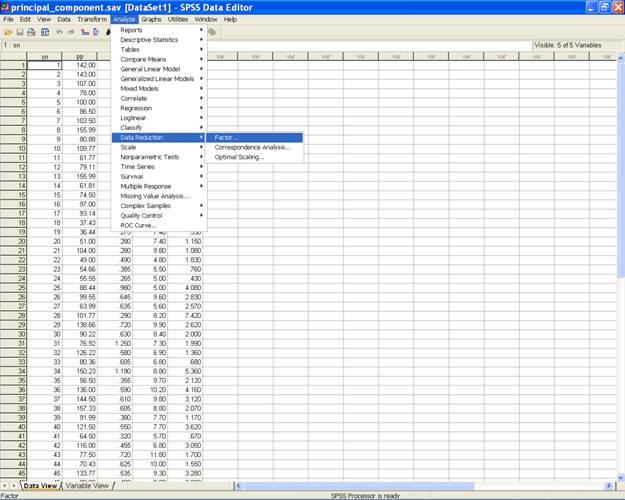
· This selection displays the following screen.

·
Select the variables
pp, ph, ngl and yield to be analyzed and send them to the
variables: box.
· This displays the following screen.
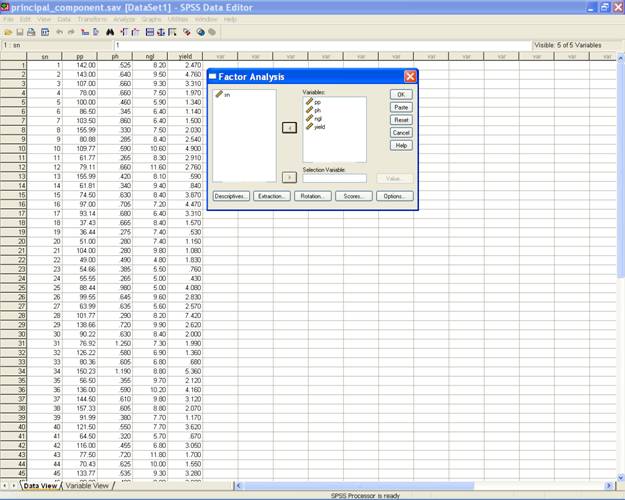
· Click on Descriptives…
· In the Statistics area: Select Univariate descriptive and Initial solutions..
· This displays the following screen.
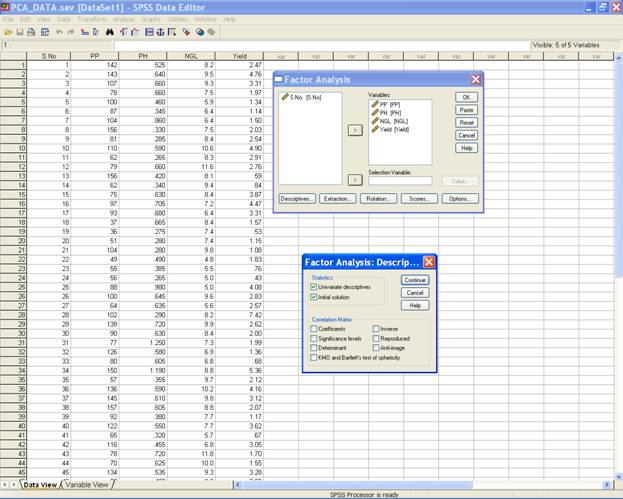
· Click on continue to return to the Factor Analysis dialog box.

· Click on Extraction. The Extraction dialog box will appear.
· Method: The default is Principal Components.
· Select Covariance matrix in the Analyze option.
· This displays the following screen.
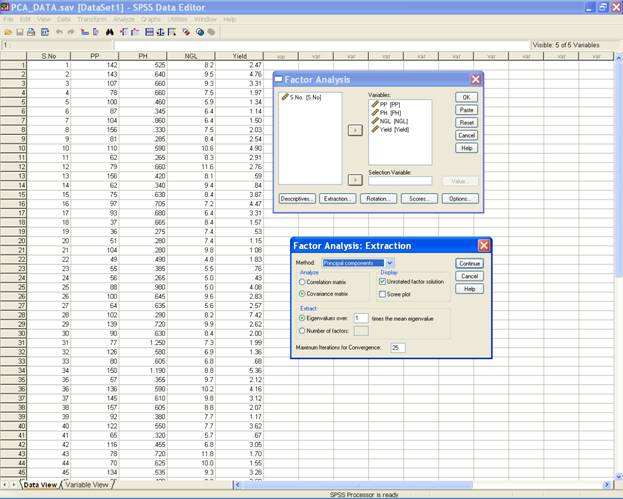
· Click on continue to return to the Factor Analysis dialog box.
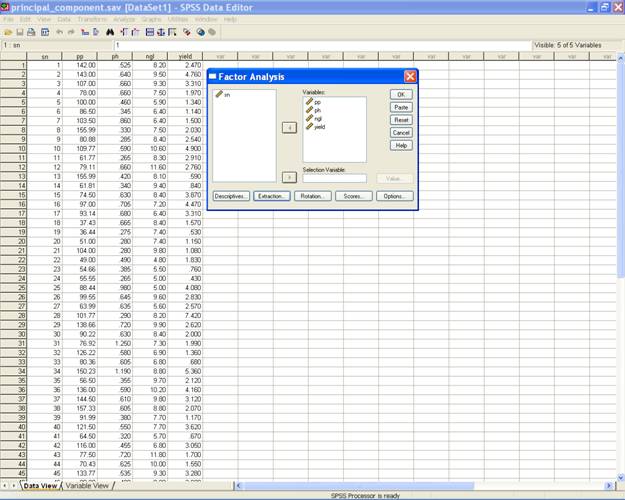
· Click on Paste to go to the syntax editor mode.
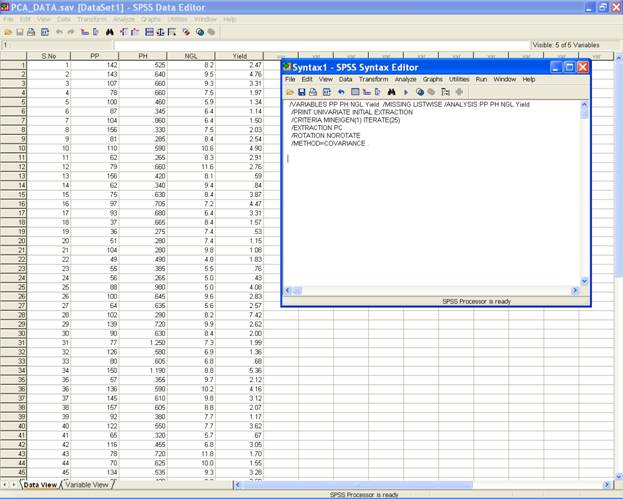
· To compute the principal component scores from the original variables using Covariance matrix use the following syntax in the syntax editor window.
MATRIX.
GET X/VARIABLES=PP,PH,NGL,YIELD.
/*READS THE DATA INTO THE MATRIX X, DEFINE THE
VARIABLES ACCORDING TO THE DATA */
COMPUTE XSSCP=SSCP(X).
/*SUM OF SQUARES AND CROSS PRODUCTS*/
COMPUTE XSUM=CSUM(X).
/*SUM OF THE VARIABLES IN THE DATA SET*/
COMPUTE N=NROW(X).
/*TOTAL NUMBER OF OBSERVATIONS*/
COMPUTE XBAR=XSUM/N.
/*MEAN OF THE VARIABLES IN THE DATA */
PRINT XBAR.
COMPUTE XX=T(XBAR)*XBAR.
COMPUTE COVMAT=(XSSCP-(N*XX))/(N-1).
/*COVARIANCE MATRIX FOR THE GIVEN DATA */
PRINT COVMAT.
CALL
EIGEN(COVMAT,EIGVEC,EIGVAL). /*COMPUTES THE EIGENVALUES AND
THE EIGENVECTORS FOR THE COVARIANCE MATRIX*/
PRINT EIGVAL.
PRINT EIGVEC.
COMPUTE TRANS=T(X).
COMPUTE TRANSA=T(EIGVEC).
COMPUTE SCORES=TRANSA*TRANS.
COMPUTE PCASCORE=T(SCORES).
/* COMPUTES THE PRINCIPAL COMPONENT SCORES*/
PRINT PCASCORE./TITLE
"PRINCIPAL COMPONENT SCORES FROM THE ORIGINAL
VARIABLES".
END MATRIX.
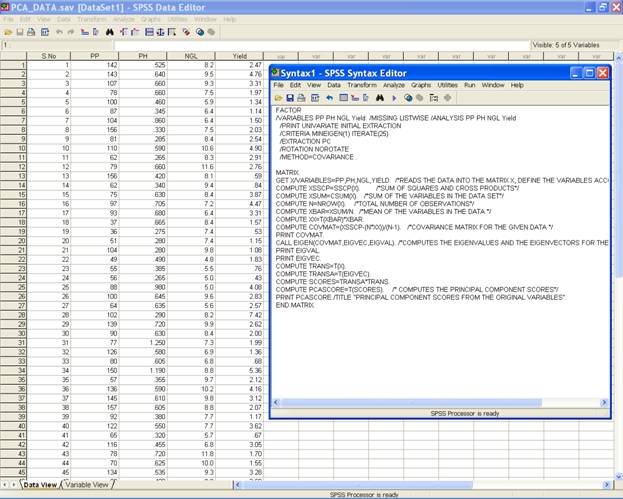
·
Click on RUN
→ ALL to get the principal component scores for
the original variables.
One can define the following syntax in the syntax editor after creating the data file to compute the principal component scores from the original variables using covariance matrix
FACTOR
/VARIABLES PP PH NGL Yield
/MISSING LISTWISE
/ANALYSIS PP PH NGL Yield
/PRINT UNIVARIATE INITIAL EXTRACTION
/CRITERIA MINEIGEN(1) ITERATE(25)
/EXTRACTION PC
/ROTATION NOROTATE
/METHOD=COVARIANCE .
MATRIX.
GET X/VARIABLES=PP,PH,NGL,YIELD. /*READS THE DATA INTO THE MATRIX X, DEFINE THE VARIABLES ACCORDING TO THE DATA */
COMPUTE XSSCP=SSCP(X). /*SUM OF SQUARES AND CROSS PRODUCTS*/
COMPUTE XSUM=CSUM(X). /*SUM OF THE VARIABLES IN THE DATA SET*/
COMPUTE N=NROW(X). /*TOTAL NUMBER OF OBSERVATIONS*/
COMPUTE XBAR=XSUM/N. /*MEAN OF THE VARIABLES IN THE DATA */
COMPUTE XX=T(XBAR)*XBAR.
COMPUTE COVMAT=(XSSCP-(N*XX))/(N-1). /*COVARIANCE MATRIX FOR THE GIVEN DATA */
PRINT COVMAT.
CALL EIGEN(COVMAT,EIGVEC,EIGVAL). /*COMPUTES THE EIGENVALUES AND THE EIGENVECTORS FOR THE COVARIANCE MATRIX*/
PRINT EIGVAL.
PRINT EIGVEC.
COMPUTE TRANS=T(X).
COMPUTE TRANSA=T(EIGVEC).
COMPUTE SCORES=TRANSA*TRANS.
COMPUTE PCASCORE=T(SCORES). /* COMPUTES THE PRINCIPAL COMPONENT SCORES*/
PRINT PCASCORE./TITLE "PRINCIPAL COMPONENT SCORES FROM THE ORIGINAL VARIABLES".
END MATRIX.
NOTE: If one wants to compute the principal component scores on the standardized data variables then use the following steps.
To compute the principal component scores from the standardized data variables using Correlation matrix use the following steps.
· To standardize the data use the following steps.
-
Choose Analyze from the Menu Bar. Now select Analyze → Descriptive Statistics → Descriptives…
· In the Descriptives dialog box select the variables and check the option save standardized values as variables.
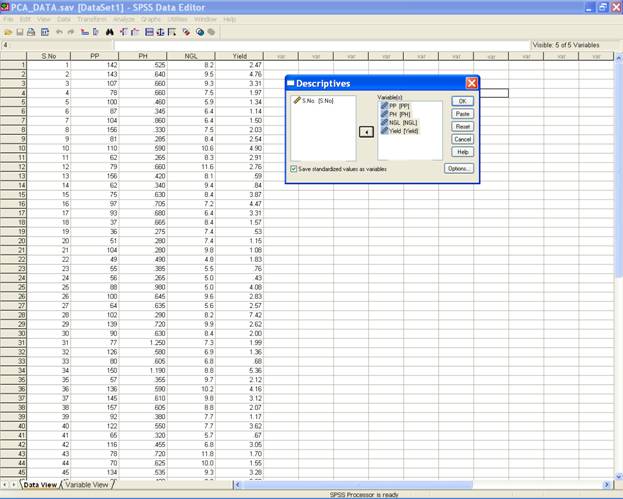
-
Click on OK to get the standardized values for the variables.
-
To perform the principal component analysis use the following steps.
-
Choose Analyze from the Menu Bar. Now select Analyze → Data Reduction → Factor…
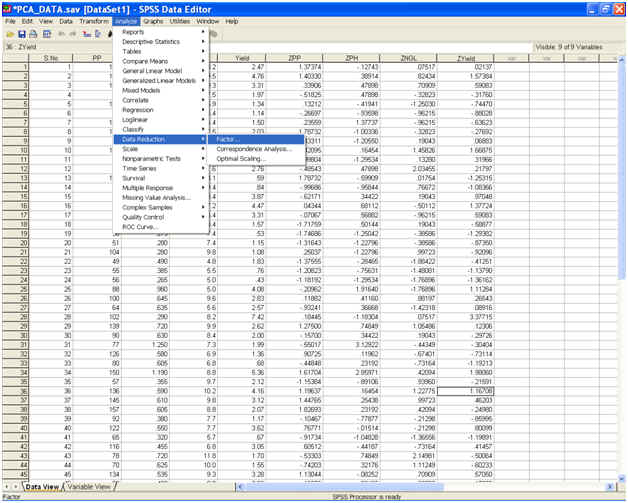
·
Select the
standardized variables zpp, zph, zngl and zyield to be analyzed and send them to the
variables: box.
· This displays the following screen.
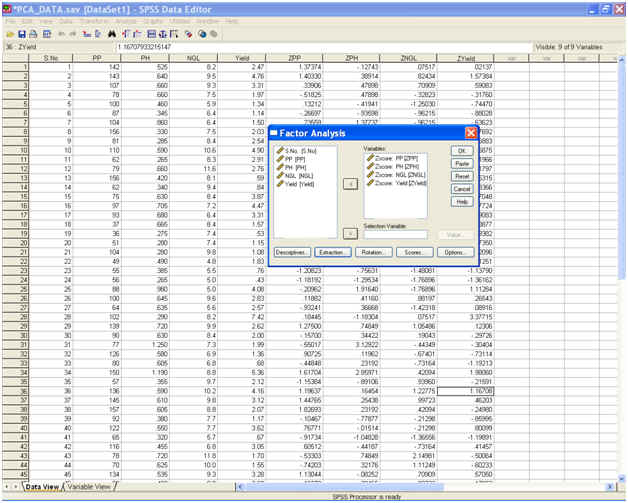
· Click on Paste to go to the Syntax mode for the computation of the principal component scores.
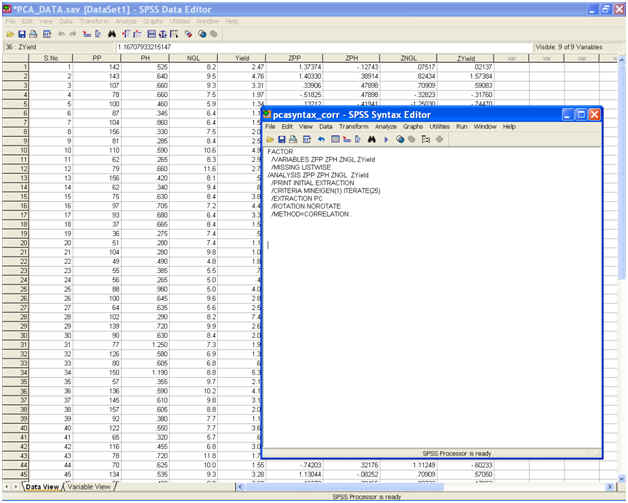
· To compute the principal component scores from the standardized data variables using Correlation matrix type the following syntax in the syntax editor window.
MATRIX.
GET
X/VARIABLES=PP,PH,NGL,YIELD.
/*READS THE DATA INTO THE MATRIX X, DEFINE THE
VARIABLES ACCORDING TO THE DATA */
COMPUTE
XSSCP=SSCP(X).
/*SUM OF SQUARES AND CROSS PRODUCTS*/
COMPUTE
XSUM=CSUM(X). /*SUM
OF THE VARIABLES IN THE DATA SET*/
COMPUTE
N=NROW(X). /*TOTAL
NUMBER OF OBSERVATIONS*/
COMPUTE
XBAR=XSUM/N. /*MEAN
OF THE VARIABLES IN THE DATA */
COMPUTE
XX=T(XBAR)*XBAR.
COMPUTE
COVMAT=(XSSCP-(N*XX))/(N-1).
/*COVARIANCE MATRIX FOR THE GIVEN DATA */
COMPUTE
D=MDIAG(SQRT(DIAG(COVMAT))).
COMPUT
R=INV(D)*COVMAT*INV(D).
/*CORRELATION MATRIX FOR THE GIVEN DATA */
PRINT
R.
CALL
EIGEN(R,REIGVEC,REIGVAL). /*COMPUTES THE EIGENVALUES AND THE
EIGENVECTORS FOR THE COVARIANCE MATRIX*/
PRINT
REIGVAL.
PRINT
REIGVEC.
GET
SX/VARIABLES=ZPP,ZPH,ZNGL,ZYIELD.
/*READS THE STANDARIZED DATA INTO THE MATRIX SX.
DEFINE THE VARIABLES ACCORDING TO THE DATA */
COMPUTE
TRANSS=T(SX).
COMPUTE
TRANSAS=T(REIGVEC).
COMPUTE
SCORESS=TRANSAS*TRANSS.
COMPUTE
PCASCORES=T(SCORESS).
/* COMPUTES THE PRINCIPAL COMPONENT SCORES*/
PRINT
PCASCORES./TITLE "PRINCIPAL COMPONENT SCORES FROM THE
STANDARDIZED VARIABLES".
END
MATRIX.
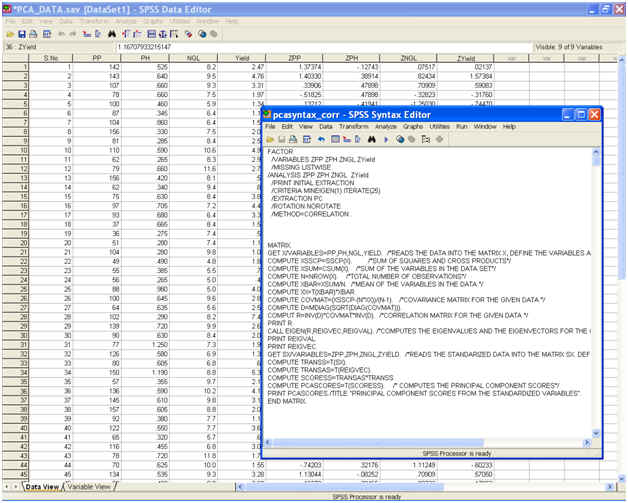
· Click on RUN → ALL to get the principal component scores from the standardized data variables.
DESCRIPTIVES
VARIABLES=PP PH NGL Yield /SAVE.
FACTOR
/VARIABLES ZPP ZPH ZNGL ZYield
/MISSING LISTWISE
/ANALYSIS ZPP ZPH ZNGL ZYield
/PRINT INITIAL EXTRACTION
/CRITERIA MINEIGEN(1) ITERATE(25)
/EXTRACTION PC
/ROTATION NOROTATE
/METHOD=CORRELATION .
MATRIX.
GET X/VARIABLES=PP,PH,NGL,YIELD. /*READS THE DATA INTO THE MATRIX X, DEFINE THE VARIABLES ACCORDING TO THE DATA */
COMPUTE XSSCP=SSCP(X). /*SUM OF SQUARES AND CROSS PRODUCTS*/
COMPUTE XSUM=CSUM(X). /*SUM OF THE VARIABLES IN THE DATA SET*/
COMPUTE N=NROW(X). /*TOTAL NUMBER OF OBSERVATIONS*/
COMPUTE XBAR=XSUM/N. /*MEAN OF THE VARIABLES IN THE DATA */
COMPUTE XX=T(XBAR)*XBAR.
COMPUTE COVMAT=(XSSCP-(N*XX))/(N-1). /*COVARIANCE MATRIX FOR THE GIVEN DATA */
COMPUTE D=MDIAG(SQRT(DIAG(COVMAT))).
COMPUT R=INV(D)*COVMAT*INV(D). /*CORRELATION MATRIX FOR THE GIVEN DATA */
PRINT R.
CALL EIGEN(R,REIGVEC,REIGVAL). /*COMPUTES THE EIGENVALUES AND THE EIGENVECTORS FOR THE COVARIANCE MATRIX*/
PRINT REIGVAL.
PRINT REIGVEC.
GET SX/VARIABLES=ZPP,ZPH,ZNGL,ZYIELD. /*READS THE STANDARIZED DATA INTO THE MATRIX SX. DEFINE THE VARIABLES ACCORDING TO THE DATA */
COMPUTE TRANSS=T(SX).
COMPUTE TRANSAS=T(REIGVEC).
COMPUTE SCORESS=TRANSAS*TRANSS.
COMPUTE PCASCORES=T(SCORESS). /* COMPUTES THE PRINCIPAL COMPONENT SCORES*/
PRINT PCASCORES./TITLE "PRINCIPAL COMPONENT SCORES FROM THE STANDARDIZED VARIABLES".
END MATRIX.
Syntax File Correlation method
Result File Correlation method
Analysis Using SAS Analysis Using SPSS
Home Descriptive Statistics Tests of Significance Correlation and Regression Completely Randomised Design RCB Design
Incomplete Block Design Resolvable Block Design Augmented Design Latin Square Design Factorial RCB Design
Partially Confounded Design Factorial Experiment with Extra Treatments Split Plot Design Strip Plot Design
Response Surface Design Cross Over Design Analysis of Covariance Diagnostics and Remedial Measures
Principal Component Analysis Cluster Analysis Groups of Experiments Non-Linear Models
Copyright Disclaimer How to Quote this page Report Error Comments/suggestions
(Under Development)
For exposure on SAS, SPSS,
MINITAB, SYSTAT and
MS-EXCEL for analysis of
data from designed experiments:
Please see Module I of Electronic Book II: Advances in Data Analytical Techniques
available
at Design Resource Server
(www.iasri.res.in/design)